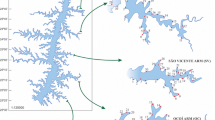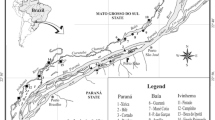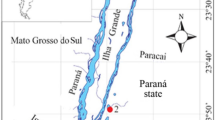Abstract
Beta-diversity measures have been used to understand patterns of community distribution in natural ecosystems. Recent studies included different facets of beta-diversity analyses, e.g. trait- and phylogeny-based. Here, we used ostracod communities to evaluate the influence of environmental and spatial factors structuring different facets of beta-diversity and their components (Beta-total, replacement and richness-difference) of ostracod communities associated with different macrophyte life forms. We test the hypotheses (1) that the influence of environmental factors is higher for ostracod beta-diversity facets of communities associated with submerged plants compared to emergent and floating plants and (2) that the influence of spatial factors is higher in communities associated with rooted, compared to non-rooted plants. Ostracods were sampled from five life forms of macrophytes, including emergent, rooted floating, rooted submerged, free submerged and free floating in 25 floodplain lakes. Our results showed that the environmental factors turned out to be important for all beta-diversity facets of ostracod communities, mainly for those associated with submerged macrophytes, thus corroborating the first hypothesis. We also found that spatial factors’ influence on ostracod beta-diversity was not related to whether the plant is rooted or not, thus refuting our second hypothesis. We also found differences in factors structuring each of the beta-diversity facets, showing the importance to include these three approaches (species-, traits- and phylogeny-based) in ecological surveys. Finally, we highlight the importance of considering different macrophyte life forms in biodiversity surveys for the preservation and management of the diversity of these plants and their associated communities.


Similar content being viewed by others
Availability of data and material
The authors declare that they can make the data available.
References
Adamec L (2008) Mineral nutrient relations in the aquatic carnivorous plant Utricularia australis and its investment in carnivory. Fund Appl Limnol 171(3):175–183. https://doi.org/10.1127/1863-9135/2008/0171-0175
Agostinho AA, Gomes LC, Veríssimo S, Okada EK (2004) Flood regime, dam regulation and fish in the upper paraná river: effects on assemblage attributes, reproduction and recruitment. Rev Fish Biol Fisher 14:11–19. https://doi.org/10.1007/s11160-004-3551-y
Aguilar-Alberola JA, Mesquita-Joanes F (2014) Breaking the temperature-size rule: Thermal effects on growth, development and fecundity of a crustacean from temporary waters. J Therm Biol 42:15–24. https://doi.org/10.1016/j.jtherbio.2014.02.016
Alahuhta J, Heino J (2013) Spatial extent, regional specificity and metacommunity structuring in lake macrophytes. J Biogeogr 40(8):1572–1582. https://doi.org/10.1111/jbi.12089
Alahuhta J, Erős T, Kärnä OM, Soininen J, Wang J, Heino J (2019) Understanding environmental change through the lens of trait-based, functional, and phylogenetic biodiversity in freshwater ecosystems. Environ Rev 27(2):263–273. https://doi.org/10.1139/er-2018-0071
Anderson MJ (2006) Distance-Based tests for homogeneity of multivariate dispersions. Biometrics 62(1):245–253. https://doi.org/10.1111/j.1541-0420.2005.00440.x
Anderson MJ, Ellingsen KE, McArdle BH (2006) Multivariate dispersion as a measure of beta diversity. Ecol Lett 9(6):683–693. https://doi.org/10.1111/j.1461-0248.2006.00926.x
Anderson MJ, Crist TO, Chase JM, Vellend M, Inouye BD, Freestone AL, Sanders NJ, Cornell HV, Comita LS, Davies KF, Harrison SP, Kraft NJB, Stegen JC, Swenson NG (2011) Navigating the multiple meanings of β diversity: a roadmap for the practicing ecologist. Ecol Lett 14(1):19–28. https://doi.org/10.1111/j.1461-0248.2010.01552.x
Baselga A (2010) Partitioning the turnover and nestedness components of beta diversity. Global Ecol Biogeogr 19(1):134–143. https://doi.org/10.1111/j.1466-8238.2009.00490.x
Borcard D, Legendre P (2002) All-scale spatial analysis of ecological data by means of principal coordinates of neighbour matrices. Ecol Model 153(1):51–68. https://doi.org/10.1016/S0304-3800(01)00501-4
Bornette G, Puijalon S (2011) Response of aquatic plants to abiotic factors: a review. Aquat Sci 73:1–14. https://doi.org/10.1007/s00027-010-0162-7
Braghin LSM, Almeida BA, Amaral DC, Canella TF, Gimenez BCG, Bonecker CC (2018) Effects of dams decrease zooplankton functional β-diversity in river-associated lakes. Freshwater Biol 63(7):721–730. https://doi.org/10.1111/fwb.13117
Brochet AL, Gauthier-Clerc M, Guillemain M, Fritz H, Waterkeyn A, Baltanás Á, Green AJ (2010) Field evidence of dispersal of branchiopods, ostracods and bryozoans by teal (Anas crecca) in the Camargue (southern France). Hydrobiologia 637:255–261. https://doi.org/10.1007/s10750-009-9975-6
Bulla CK, Gomes LC, Miranda LE, Agostinho AA (2011) The ichthyofauna of drifting macrophyte mats in the Ivinhema River, upper Paraná River basin. Brazil Neotrop Ichthyol 9(2):403–409. https://doi.org/10.1590/S1679-62252011005000021
Cadotte MW, Carscadden K, Mirotchnick N (2011) Beyond species: functional diversity and the maintenance of ecological processes and services. J Appl Ecol 48(5):1079–1087. https://doi.org/10.1111/j.1365-2664.2011.02048.x
Cai Y, Zhang Y, Hu Z, Deng J, Qin B, Yin H, Wang X, Gong Z, Heino J (2019) Metacommunity ecology meets bioassessment: assessing spatio-temporal variation in multiple facets of macroinvertebrate diversity in human-influenced large lakes. Ecol Indic 103:713–721. https://doi.org/10.1016/j.ecolind.2019.03.016
Campos R, Conceição EO, Pinto MBO, Bertoncin APS, Higuti J, Martens H (2017) Evaluation of quantitative sampling methods in pleuston: an example from ostracod communities. Limnologica 63:36–41. https://doi.org/10.1016/j.limno.2017.01.002
Campos R, Conceição EO, Martens K, Higuti J (2019) Extreme drought periods can change spatial effects on periphytic ostracod metacommunities in river-floodplain ecosystems. Hydrobiologia 828:369–381. https://doi.org/10.1007/s10750-018-3825-3
Cardoso P, Rigal F, Carvalho JC (2015) BAT - Biodiversity assessment tools, an R package for the measurement and estimation of alpha and beta taxon, phylogenetic and functional diversity. Methods Ecol Evol 6(2):232–236. https://doi.org/10.1111/2041-210X.12310
Castillo-Escrivà A, Rueda J, Zamora L, Hernández R, Moral M, Mesquita-Joanes F (2016a) The role of watercourse versus overland dispersal and niche effects on ostracod distribution in Mediterranean streams (eastern Iberian Peninsula). Acta Oecol 73:1–9. https://doi.org/10.1016/j.actao.2016.02.001
Castillo-Escrivà A, Valls L, Rochera C, Camacho A, Mesquita-Joanes F (2016b) Spatial and environmental analysis of an ostracod metacommunity from endorheic lakes. Aqua Sci 78(4):707–716. https://doi.org/10.1007/s00027-015-0462-z
Castillo-Escrivà A, Valls L, Rochera C, Camacho A, Mesquita-Joanes F (2017) Disentangling environmental, spatial, and historical effects on ostracod communities in shallow lakes. Hydrobiologia 787:1–12. https://doi.org/10.1007/s10750-016-2945-x
Cattaneo A, Galanti G, Gentinetta S, Romo S (1998) Epiphytic algae and macroinvertebrates on submerged and floating-leaved macrophytes in an Italian lake. Freshwater Biol 39(4):725–740. https://doi.org/10.1046/j.1365-2427.1998.00325.x
Cazzanelli M, Warming TP, Christoffersen KS (2008) Emergent and floating-leaved macrophytes as refuge for zooplankton in a eutrophic temperate lake without submerged vegetation. Hydrobiologia 605:113–122. https://doi.org/10.1007/s10750-008-9324-1
Choi JY, Jeong KS, La GH, Kim SK, Joo GJ (2014) Sustainment of epiphytic microinvertebrate assemblage in relation with different aquatic plant microhabitats in freshwater wetlands (South Korea). J Limnol 73(1):197–202. https://doi.org/10.4081/jlimnol.2014.736
Clarke KR, Warwick RM (1998) A taxonomic distinctness index and its statistical properties. J Appl Ecol 35(4):523–531. https://doi.org/10.1046/j.1365-2664.1998.3540523.x
Cremona F, Dolors P, Marc L (2008) Biomass and composition of macroinvertebrate communities associated with different types of macrophyte architectures and habitats in a large fluvial lake. Fund Appl Limnol 171(2):119–130. https://doi.org/10.1127/1863-9135/2008/0171-0119
Devictor V, Mouillot D, Meynard C, Jiguet F, Thuiller W, Mouquet N (2010) Spatial mismatch and congruence between taxonomic, phylogenetic and functional diversity: The need for integrative conservation strategies in a changing world. Ecol Lett 13(8):1030–1040. https://doi.org/10.1111/j.1461-0248.2010.01493.x
Ferreira VG, Higuti J, Martens K (2020) Taxonomic revision of Strandesia ss (Crustacea, Ostracoda) from four Brazilian floodplains, with the description of three new species. Zootaxa 4760(1):1–74. https://doi.org/10.11646/zootaxa.4760.1.1
Fontanarrosa MS, Chaparro GN, O’Farrell I (2013) Temporal and spatial patterns of macroinvertebrates associated with small and medium-sized free-floating plants. Wetlands 33(1):47–63. https://doi.org/10.1007/s13157-012-0351-3
Forest F, Grenyer R, Rouget M, Davies J, Cowling D, Faith DP, Balmford A, Manning JC, Proches S, Bank MV, Reeves G, Hedderson TAJ, Savolainen V (2007) Preserving the evolutionary potential of floras in biodiversity hotspots. Nature 445:757–760. https://doi.org/10.1038/nature05587
Gower JC (1971) A general coefficient of similarity and some of its properties. Biometrics 27(4):857–871. https://doi.org/10.2307/2528823
Graham CH, Fine PVA (2008) Phylogenetic beta diversity: linking ecological and evolutionary processes across space in time. Ecol Lett 11(12):1265–1277. https://doi.org/10.1111/j.1461-0248.2008.01256.x
Graham CH, Parra JL, Rahbek C, McGuire JA (2009) Phylogenetic structure in tropical hummingbird communities. P Natl Acad Sci Usa 106:19673–19678. https://doi.org/10.1073/pnas.0901649106
Guisande C, Andrade C, Granado-Lorencio C, Duque SR, Avellaneda N (2000) Effects of zooplankton and conductivity on tropical Utricularia foliosa investment in carnivory. Aquat Ecol 34:137–142. https://doi.org/10.1023/A:1009966231287
Heck KL, van Belle G, Simberloff D (1975) Explicit calculation of the rarefaction diversity measurement and the determination of sufficient sample size. Ecology 56:1459–1461. https://doi.org/10.2307/1934716
Higuti J, Martens K (2012a) Description of a new genus and species of Candonopsini (Crustacea, Ostracoda, Candoninae) from the alluvial valley of the Upper Paraná River (Brazil, South America). Eur J Taxon 33:1–31. https://doi.org/10.5852/ejt.2012.33
Higuti J, Martens K (2012b) On a new cypridopsine genus (Crustacea, Ostracoda, Cyprididae) from the upper paraná river floodplain (Brazil). Zootaxa 3391(1):23–38. https://doi.org/10.11646/zootaxa.3391.1.2
Higuti J, Martens K (2014) Five new species of Candoninae (Crustacea, Ostracoda) from the alluvial valley of the Upper Paraná River (Brazil, South America). Eur J Taxon 106:1–36. https://doi.org/10.5852/ejt.2014.106
Higuti J, Martens K (2016) Invasive South American floating plants are a successful substrate for native central African Pleuston. Bio Invasions 18:1191–1201. https://doi.org/10.1007/s10530-016-1061-1
Higuti J, Lansac-Tôha FA, Velho LFM, Martens K (2009) Biodiversity of non-marine ostracods (Crustacea, Ostracoda) in the alluvial valley of the upper Paraná River, Brazil. Braz J Biol 69(2):661–668. https://doi.org/10.1590/S1519-69842009000300020
Higuti J, Declerck SAJ, Lansac-Tôha FA, Velho LFM, Martens K (2010) Variation in ostracod (Crustacea, Ostracoda) communities in the alluvial valley of the upper Paraná River (Brazil) in relation to substrate. Hydrobiologia 644:261–278. https://doi.org/10.1007/s10750-010-0122-1
Higuti J, Schön I, Audenaert L, Martens K (2013) On the Strandesia obtusata/elliptica lineage (Ostracoda, Cyprididae) in the alluvial valley of the upper Paraná River (Brazil), with the description of three new species. Crustaceana 86(2):182–211. https://doi.org/10.1163/15685403-00003160
Higuti J, Conceição EO, Campos R, Ferreira VG, Rosa J, Pinto MBO, Martens K (2017) Periphytic community structure of Ostracoda (Crustacea) in the river-floodplain system of the Upper Paraná River. Acta Limnol Bras 29:e120. https://doi.org/10.1590/s2179-975x12217
Holyoak M, Leibold MA, Mouquet N, Holt RD, Hoopes M (2005) A framework for large scale community ecology. In: Holyoak M, Leibold MA, Holt RD (eds) Metacommunities: spatial dynamics and ecological communities, 1st edn. The University of Chicago Press, Chicago, pp 1–31
Horne DJ, Danielopol DL, Martens K (1998) Reproductive behaviour. In: Martens K (ed) Sex and parthenogenesis: evolutionary ecology of reproductive modes in non-marine ostracods. Backhuys Publish, Netherlands, pp 157–196
Hsieh TC, Ma KH, Chao A (2016) iNEXT: an R package for rarefaction and extrapolation of species diversity (H ill numbers). Methods Ecol Evo 7(12):1451–1456. https://doi.org/10.1111/2041-210X.12613
Junk WJ, Bayley PB, Sparks RE (1989) The flood pulse concept in river-floodplain systems. Can Spec Publ Fish Aquat Sci 106(1):110–127
Krasnov BR, Shenbrot GI, Korallo-Vinarskaya NP, Vinarski MV, Warburton EM, Khokhlova IS (2019) The effects of environment, hosts and space on compositional, phylogenetic and functional beta-diversity in two taxa of arthropod ectoparasites. Parasitol Res 118:2107–2120. https://doi.org/10.1007/s00436-019-06371-1
Laliberté E, Legendre P, Shipley B, Laliberté ME (2014) Measuring functional diversity from multiple traits, and other tools for functional ecology. R Pack Vers 1:10–12
Landeiro VL, Magnussum WE, Melo AS, Espírito-Santo HMV, Bini LM (2011) Spatial eigenfunction analyses in stream networks: do watercourse and overland distances produce different results? Freshwater Biol 56(6):1184–1192. https://doi.org/10.1111/j.1365-2427.2010.02563.x
Legendre P (2014) Interpreting the replacement and richness difference components of beta diversity. Global Ecol Biogeogr 23(11):1324–1334. https://doi.org/10.1111/geb.12207
Legendre P, Anderson MJ (1999) Distance-based redundancy analysis: testing multispecies responses in multifactorial ecological experiments. Ecol Monogr 69(1):1–24. https://doi.org/10.1890/0012-9615(1999)069[0001:DBRATM]2.0.CO;2
Legendre P, Legendre L (1998) Numerical ecology. Elsevier Science, Amsterdam
Legendre P, Borcard D, Peres-Neto PR (2005) Analyzing beta diversity: partitioning the spatial variation of community composition data. Ecol Monogr 75(4):435–450. https://doi.org/10.1890/05-0549
Leibold MA, Holyoak M, Mouquet N, Amarasekare P, Chase JM, Hoopes MF, Holt RD, Shurin JB, Law R, Tilman D, Loreau M, Gonzalez A (2004) The metacommunity concept: a framework for multi-scale community ecology. Ecol Lett 7(7):601–613. https://doi.org/10.1111/j.1461-0248.2004.00608.x
Liberto R, Mesquita-Joanes F, César I (2012) Dynamics of pleustonic ostracod populations in small ponds on the Island of Martín García (Río de la Plata, Argentina). Hydrobiologia 688:47–61. https://doi.org/10.1007/s10750-011-0600-0
Marmonier P, Bodergat AM, Dolédec S (1994) Theoretical habitat templets, species traits, and species richness: ostracods (Crustacea) in the upper rhône river and its floodplain. Freshwater Biol 31:341–355. https://doi.org/10.1111/j.1365-2427.1994.tb01745.x
Martens K, Behen F (1994) A Checklist of the recent non-marine ostracods (Crustacea, Ostracoda) from the Inland Waters of South America and Adjacent Islands. Trav sci Mus nat hist nat Luxembourg 22:1–81
Matsuda JT, Lansac-Tôha FA, Martens K, Velho LFM, Mormul RP, Higuti J (2015) Association of body size and behavior of freshwater ostracods (Crustacea, Ostracoda) with aquatic macrophytes. Aquat Ecol 49:321–331. https://doi.org/10.1007/s10452-015-9527-2
Mazzini I, Ceschin S, Abati S, Gliozzi E, Piccari F, Rossi A (2014) Ostracod communities associated to aquatic macrophytes in an urban park in Rome. Italy Int Rev Hydrobiol 99(6):425–434. https://doi.org/10.1002/iroh.201301728
McAbendroth L, Ramsay PM, Foggo A, Rundle SD, Bilton DT (2005) Does macrophyte fractal complexity drive invertebrate diversity, biomass and body size distributions? Oikos 111(2):279–290. https://doi.org/10.1111/j.0030-1299.2005.13804.x
Meerhoff M, Mazzeo N, Moss B, Gallego R (2003) The structuring role of free-floating versus submerged plants in a subtropical shallow lake. Aquat Ecol 37:377–391. https://doi.org/10.1023/B:AECO.0000007041.57843.0b
Meisch C (2000) Freshwater Ostracoda of Western and Central Europe. In: Schwoerbel J, Zwick P (eds) Süsswasserfauna von Mitteleuropa. Spektrum Akademischer Verlag, Berlin, Germany, pp 1–522
Meisch C, Smith RJ, Martens K (2019) A subjective global checklist of the extant non-marine Ostracoda (Crustacea). Eur J Taxon 492:1–135. https://doi.org/10.5852/ejt.2019.492
Mesquita-Joanes F, Smith AJ, Viehberg FA (2012) The ecology of Ostracoda across levels of biological organisation from individual to ecosystem: a review of recent developments and future potential. In: Horne DJ, Holmes JA, Rodríguez-Lázaro J, Viehberg FA (eds) Ostracoda as proxies for quaternary climate change. Elsevier, Amsterdam, pp 15–35
Nagorskaya L, Keyser D (2005) Habitat diversity and ostracod distribution patterns in Belarus. Hydrobiologia 538:167–178. https://doi.org/10.1007/s10750-004-4959-z
Neiff ASP, Casco SL (2003) Biological agents that accelerate winter decay of Eichhornia crassipes Mart. Solms. in northeastern Argentina. In: Thomas SM, Bini LM (eds) Ecologia e Manejo de macrófitas aquáticas. Editora da Universidade Estadual de Maringá, Maringá, pp 127–144
Oksanen J, Blanchet FG, Kindt R (2017) Vegan: Community ecology package. Version 2.3–3. https://cran.r-project.org/web/packages/vegan/ (Accessed 26 Mar 2019)
Pereira LC, Lansac-Tôha FA, Martens K, Higuti J (2017) Biodiversity of ostracod communities (Crustacea, ostracoda) in a tropical floodplain. Inland Waters 7(3):323–332. https://doi.org/10.1080/20442041.2017.1329913
Perez Rocha M, Bini LM, Domisch S, Tolonen KT, Jyrkänkallio-Mikkola J, Soininen J, Hjort J, Heino J (2018) Local environment and space drive multiple facets of stream macroinvertebrate beta diversity. J Biogeogr 45(12):2744–2754. https://doi.org/10.1111/jbi.13457
Pott VJ, Pott A (2000) Plantas aquáticas do Pantanal. EMBRAPA Comunicação para transferência de Tecnologia, Corumbá, MS
R Core Team (2017) R: A language and environment for statistical com- puting. Vienna, Austria: R Foundation for Statistical Computing. Retrieved from https://www.R-project.org/ (Accessed 26 June 2019)
Rehman F, Pervez A, Mahmood Q, Nawab B (2017) Wastewater remediation by optimum dissolve oxygen enhanced by macrophytes in constructed wetlands. Ecol Eng 102:112–126. https://doi.org/10.1016/j.ecoleng.2017.01.030
Rocha CEF, Por FD (1998) Preliminary comparative data on the fauna of the pleuston in the Southern Pantanal, Brazil, with emphasis on the microcrustaceans. Verh Internat Verein Limnol 26:2137–2140. https://doi.org/10.1080/03680770.1995.11901121
Rossetti G, Martens K (1998) Taxonomic revision of the Recent and Holocene representatives of the family Darwinulidae (Crustacea, Ostracoda), with a description of three new genera. Bull Inst R Sc Nat Belg Biol 68:55–110
Ruiz F, Abad M, Bodergat AM, Carbonel P, Rodríguez-Lázaro J, González-Regalado ML, Toscano A, García EX, Prenda J (2013) Freshwater ostracods as environmental tracers. Int J Environ Sci Technol 10(5):1115–1128. https://doi.org/10.1007/s13762-013-0249-5
Scheffer M, Hosper SH, Meijer ML, Jeppesen MB (1993) Alternative equilibria in shallow lakes. Trends Ecol Evol 8:275–279. https://doi.org/10.1016/0169-5347(93)90254-M
Souza DC, Cunha ER, Murillo RA, Silveira MJ, Pulzatto MM, Dainez-Filho MS, Lolis LA, Thomaz SM (2017) Species inventory of aquatic macrophytes in the last undammed stretch of the Upper Paraná River, Brazil. Acta Limnol Bras 29:e115. https://doi.org/10.1590/s2179-975x6017
Souza Filho E (2009) Evaluation of the Upper Paraná River discharge controlled by reservoirs. Braz J Biol 69(2):707–716. https://doi.org/10.1590/S1519-69842009000300024
Thomaz SM, Cunha ER (2010) The role of macrophytes in habitat structuring in aquatic ecosystems: methods of measurement, causes and consequences on animal assemblages’ composition and biodiversity. Acta Limnol Bras 22(2):218–236. https://doi.org/10.4322/actalb.02202011
Thomaz SM, Dibble ED, Evangelista LR, Higuti J, Bini LM (2008) Influence of aquatic macrophyte habitat complexity on invertebrate abundance and richness in tropical lagoons. Freshwater Biol 53(2):358–367. https://doi.org/10.1111/j.1365-2427.2007.01898.x
Walker PD, Wijnhoven S, Velde GV (2013) Macrophyte presence and growth form influence macroinvertebrate community structure. Aquat Bot 104:80–87. https://doi.org/10.1016/j.aquabot.2012.09.003
Weinstein BG, Tinoco B, Parra JL, Brown LM, McGuire JA, Stiles FG, Graham CH (2014) Taxonomic, phylogenetic, and trait beta diversity in South American Hummingbirds. Am Nat 184(2):211–224. https://doi.org/10.1086/676991
Winter M, Devictor V, Shweiger O (2013) Phylogenetic diversity and nature conservation: where are we? Trends Ecol Evol 28(4):199–204. https://doi.org/10.1016/j.tree.2012.10.015
Yamaki A, Yamamuro M (2013) Floating-leaved and emergent vegetation as habitat for fishes in a eutrophic temperate lake without submerged vegetation. Limnology 14:257–268. https://doi.org/10.1007/s10201-013-0403-2
Acknowledgements
We thank the Centre of Research in Limnology, Ichthyology and Aquaculture (Nupélia) and the Graduate Program in Ecology of Inland Water Ecosystems (PEA) of the State University of Maringá (UEM) for logistic support. We also thank Dr Fernando M. Lansac-Toha and Dr Danielle K. Petsch for statistical support and Jaime Luiz Lopes Pereira (Nupélia) for the production of the map. R.C., V.G.F. and E.O.C. would like to thank CAPES, and J.R. would like to thank to CNPq for granting their scholarships. The State University of Maringá (UEM, Maringá) and the Royal Belgian Institute of natural Sciences (RBINS, Brussels) have a bilateral Memorandum of Understanding regarding collaborative Scientific Research. Two anonymous referees offered important comments that improved the paper significantly.
Funding
This work was funded by Ministry of Science and Technology (MCT)/National Council for Scientific and Technological Development (CNPq) through the Long-Term Ecological Research (LTER, site 6) and Academic Excellency Program (PROEX)/Coordination for the Improvement of Higher Education Personnel (CAPES).
Author information
Authors and Affiliations
Contributions
RC, JH and KM designed the research. All authors contributed to the ostracod sampling. RC, VGF, JR and EOC contributed to the ostracod sorting and identification. RC wrote the first draft of the manuscript and all authors contributed to the final version of the manuscript.
Corresponding author
Ethics declarations
Conflict of interest
The authors declare that they have no conflict of interest
Consent for publication
All authors significantly contributed to further manuscript revisions and gave final approval for publication.
Additional information
Publisher's Note
Springer Nature remains neutral with regard to jurisdictional claims in published maps and institutional affiliations.
Supplementary Information
Below is the link to the electronic supplementary material.
Rights and permissions
About this article
Cite this article
de Campos, R., Rosa, J., Ferreira, V.G. et al. Macrophyte life forms influence the effects of environmental and spatial factors on the beta-diversity of associated ostracod communities (Crustacea). Aquat Sci 83, 27 (2021). https://doi.org/10.1007/s00027-021-00777-9
Received:
Accepted:
Published:
DOI: https://doi.org/10.1007/s00027-021-00777-9




